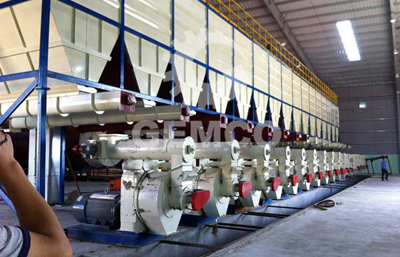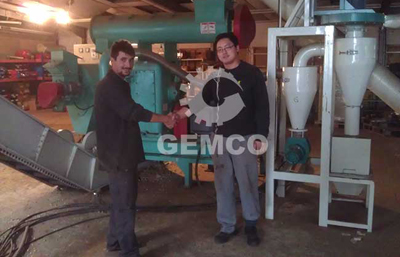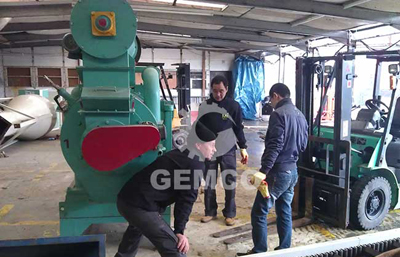Compare biomass pellets with conventional fuels
Biomass is an alternative for coal, oil, and natural gas
Energy is essential to the development of our society. With the increase of energy demand, the conventional fuels like coal, oil and natural gas will run out soon. And they have caused serious pollution. So we need to develop new energy.
Owing to rich reserves, cleanliness, and convenience, biomass become one of the renewable energies with great promise. Biomass is chemical power transformed from solar power by photosynthesis of the plants. In other words, it is solar power deposited in plants in the form of chemical power. It has the advantages of both fossil fuels and other renewable energy.

The history of direct use of biomass energy has been thousand of years. For example, the burning of firewood and crop straws. Biomass has been playing a role in heating and cooking in human life. But direct burning of biomass is inefficient and polluting. The bulky biomass materials are hard to store and transport.
Biomass pellets are made by compressing straws, rice husk, sawdust, and other agriculture wastes. Under mechanical pressure, the bulky and incompact raw materials are formed into high-density solid fuels. Biomass pellets are easy to store and transport. The combustion is continuous and stable, with high efficiency. Their ash and slag contains little pollutions.
Compositions of biomass pellets
Biomass pellets are mainly composed of combustible basis, inorganic matters, and water. The main elements are carbon, hydrogen, oxygen, nitrogen, sulfur, water, and ash.
| Carbon | Hydrogen | Volatiles | Sulfur | Nitrogen | Ash | Moisture |
|---|---|---|---|---|---|---|
| 40-45% | 8-10% | 75% | <0.02% | <0.15% | 1%-2% | ≤10% |
Notes:
- Low fixed carbon content makes it easy to burn.
- Volatiles are low-molecular hydrocarbons composed by carbon and hydrogen elements, which will separate out by thermal decomposition at high temperature.
- The pellet burning equipment doesn’t need a desulfurizer, which lowers the cost and benefits environment.
- The SO2 and NOx emission in wood pellet combustion can meet the emission standard.
- The density of biomass pellet fuels is 1.1-1.4t/m3.
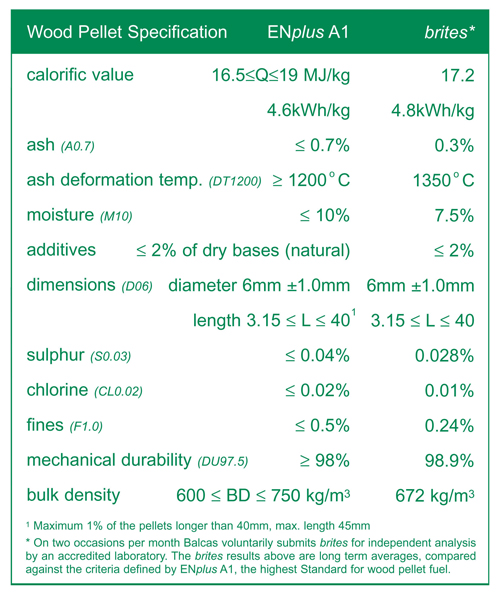
Cost of wood pellets and conventional fuels
In terms of cost, coal<biomass<electricity<natural gas<oil
- Coal is the lowest in cost. But coal boilers cause pollution to the environment. In many regions, coal has been forbidden.
- Biomass is a little higher than coal in cost, but it is much cheaper than electricity, natural gas, and oil. And the pollutant emission is much lower than coals. It is a green and economical energy.
- Electricity is clean and costs low, but the electric consumption is rather high. In the condition of power cuts or power rationing, the production have to delay or stop. Improper voltage arrangement are easy to cause black out.
- Natural gas is environment-friendly, and the cost is not high. But the price is on the rise. Currently, the price of natural gas goes up in many places, which will keep on in the future.
- Oil production is large and the supply is abundant. But the price is the highest of all these fuels.
Calorific value of biomass pellets and conventional fuels
| Fuels |
Average calorific value kcal/kg |
Price Yuan/kg | Heat utilization rate |
Price for heating 1t water to 100℃ |
Pollutant |
|---|---|---|---|---|---|
| raw coal | 4984 | 1 | 0.80 | 25.08 | sulphur |
| crude oil | 9969 | 4.7 | 0.85 | 55.47 | sulphur |
| gasoline | 10268 | 10 | 0.85 | 114.58 | sulphur |
| kerosene | 10268 | 9 | 0.85 | 103.12 | sulphur |
| diesel | 10168 | 8.5 | 0.85 | 98.35 | sulphur |
| liquefied petroleum gas | 11303 | 7.93 | 0.85 | 82.54 | sulphur |
| coke oven gas | 3987kcal/m3 | 7.6 | 0.85 | 224.50 | sulphur |
| electricity |
857 kcal/KWH |
0.5 yuan/KWH |
0.90 | 25.25 | none |
| wood pellets | 4400 | 1 | 0.90 | 25.25 | none |
Operation cost of biomass, natural gas and oil in boilers
| Property | Biomass fuel | Natural gas | Diesel | Heavy oil |
|---|---|---|---|---|
| Calorific value (Kcal/kg) | 4100 | 8600 | 10200 | 10000 |
| boiler efficiency (%) | 89% | 90% | 90% | 89% |
| Consumption for 1 ton of steam(kg/t) | 164.4 | 77.5 | 65.4 | 67.4 |
| Cost for 1 ton of steam(yuan/t) | 246.6 | 310.0 | 425.1 | 316.8 |
| Fuel cost increase (%) | - | 21% | 42% | 22% |
Advantages of biomass pellet fuel
- Biomass pellets has high heat value of 3900-4800Kcal/kg. After carbonization, the heat value goes up to 7000-8000Kcal/kg.
- Biomass pellets features high purity, with little impurities that don't generate heat. The carbon content is 75-85%, the ash content is 3-6%, the moisture is 1-3%, without coal gangues that consume heat.
- Biomass pellets doesn’t contains sulfur or phosphorus that cause corrosion to the boilers. So it can prolong the working life of boilers, and save cost for companies.
- Without sulfur or phosphorus content, biomass pellet doesn’t generate SO2 or P5O2 in burning. It has little pollution to the atmosphere.
- Biomass pellets are small and uniform in size. It can be fed to the boilers automatically, which reduce labor cost and improve the working environment.
- The ash residues after wood pellets combustion is little. It doesn't take much space to pile up the coal cinder, or take must cost to remove the slag.
- The ash residues generated in wood pellets combustion are high quality organic potassium fertilizer that can be recycled to make profits.
- Many countries and regions has made policies to support biomass energy, and provide subsidies for the use of biomass fuels.
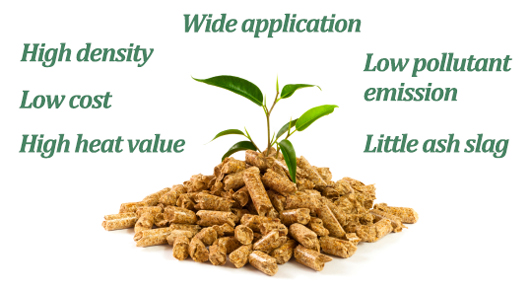
Where are biomass pellet fuel used?
Home heating stove
Heating stoves are more popular in developed countries like north Europe. It is used for heating or supplying hot water. The heating stove can form a home heating system by connecting with pipelines, tanks, and heating radiators. In the old days, these heating stoves adopts firewood as fuels. Nowadays, more and more of them use wood pellets as fuel. the latter is more clean and convenient.
Industrial boiler
To use wood pellet fuel in boilers can reduce the cost for fuel and waste processing. Biomass fuel is more environment friendly than coal and firewood, and cheaper than natural gas and oil. Biomass fuels also have high heat value, stable combustion effect, and low ash discharge.
Biomass power plant
Biomass power generation began in the 1970s. It has 3 technologies: biomass direct burning, coal and biomass co-firing, and biomass gasification. In short, the burning of biomass pellets heat up the steams, the steams drive the turbo generator. Nowadays, biomass power generation technology has been mature in developed countries.
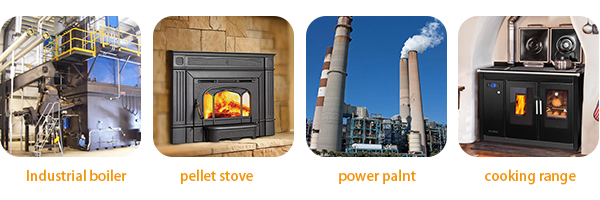
We receive enquiries in English, Español (Spanish), Русский язык (Russian), Français (French) and العربية (Arabic). Our professional team will reply to you within one business day. Please feel free to contact us!
